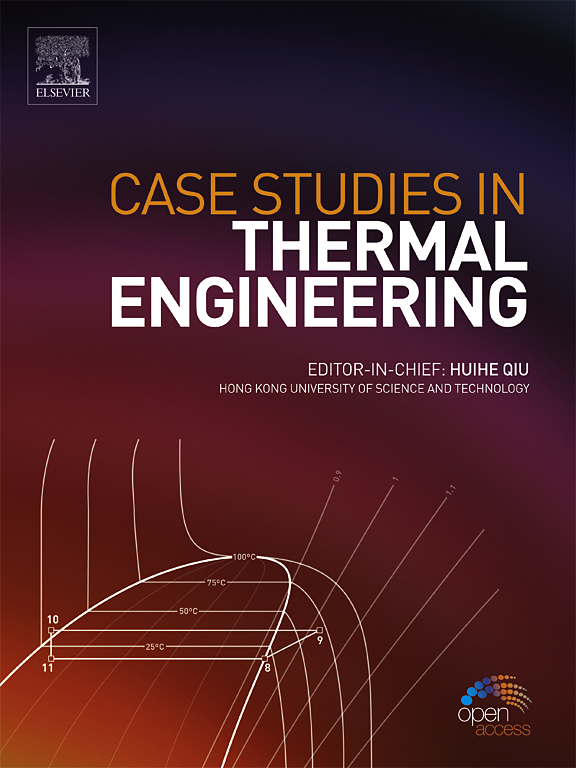Numerical analysis of thermal and hydrothermal characteristics of a heat sink with various fin configurations and ternary nanofluid composition
IF 6.4
2区 工程技术
Q1 THERMODYNAMICS
引用次数: 0
Abstract
Effectively managing thermal conditions and controlling temperatures in electrical, electronic, and electrochemical devices has long been a challenge to their optimal operation and continual development. In recent decades, liquid-cooled heat sinks and enhancements in their heat dissipation capabilities have emerged as effective solutions. This study aims to improve hydrothermal efficiency and achieve better temperature uniformity within heat sinks. Various configurations of fins with innovative geometrical designs including a baseline case and cases 1 through 4 have been developed to analyze how these geometric parameters influence angled fin heat sink (AFHS) performance and temperature distribution. Each model's enhancement through hydrothermal methods is assessed against the baseline using a metric known as performance evaluation criteria (PEC). Case 2 at Re 1600 has 28.29 % more Nu than Re 1000. The Nu value of case 2 at Re 1200 increases by 14.72 % and 46.75 % compared to case 1 and the base case. Using pure water has shown that case 4 has the highest pressure drop compared to the other cases. case 4 at Re 1400 has a 30.82 % higher pressure drop than Re 1200. The pressure drops in case 4 at Re 1200 has increased by 367.89 Pa, 308.27 Pa, 215.92 Pa, and 45.18 Pa compared to the base case, case 1, case 2, and case 3. Additionally, the research evaluates the effects of a water-based ternary hybrid nanofluid (THNF) containing ZnO-GO-Al2O3 nanoparticles at different volume fractions compared to distilled water in the AFHS designed for optimal hydrothermal performance. The findings indicate that case 3 has better performance than the other cases. As a result, with changes in the fin arrangement of case 3, new configurations 3A, 3B, 3C and 3D were introduced. The results show that case 3C shows the best performance among all geometries. The distribution of temperature within the AFHS is significantly influenced by the effective heat transfer area and average heat transfer coefficient (HTC), with the system's pressure drop having a more substantial impact on the PEC than other functional and hydrothermal parameters. Furthermore, the PEC for the system utilizing a 6 % volume fraction of nanofluid decreased by nearly 50 % in comparison to the baseline (Case 3), while the PEC for systems incorporating nanofluids with volume fractions of 2 % and 4 % saw reductions of approximately 20 % and 35 %, respectively.
求助全文
约1分钟内获得全文
求助全文
来源期刊

Case Studies in Thermal Engineering
Chemical Engineering-Fluid Flow and Transfer Processes
CiteScore
8.60
自引率
11.80%
发文量
812
审稿时长
76 days
期刊介绍:
Case Studies in Thermal Engineering provides a forum for the rapid publication of short, structured Case Studies in Thermal Engineering and related Short Communications. It provides an essential compendium of case studies for researchers and practitioners in the field of thermal engineering and others who are interested in aspects of thermal engineering cases that could affect other engineering processes. The journal not only publishes new and novel case studies, but also provides a forum for the publication of high quality descriptions of classic thermal engineering problems. The scope of the journal includes case studies of thermal engineering problems in components, devices and systems using existing experimental and numerical techniques in the areas of mechanical, aerospace, chemical, medical, thermal management for electronics, heat exchangers, regeneration, solar thermal energy, thermal storage, building energy conservation, and power generation. Case studies of thermal problems in other areas will also be considered.
 求助内容:
求助内容: 应助结果提醒方式:
应助结果提醒方式:


